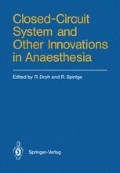Abstract
In the past, uncertainty regarding the inspiratory concentration during closed-circuit anaesthesia made the clinical application of closed-circuit unpopular. However, the new concepts in uptake of inhalation anaesthetic [1] including (1) uptake is at its peak at the end of functional residual capacity (FRC) wash-in and remains near constant for a given inspired anaesthetic concentration; (2) uptake depends on inspired concentration- if the inspired concentration increases, uptake increases; and (3) large circuit volume and FRC serve as buffers; allowing closedcircuit anaesthesia to be practiced with simplicity and with minimal requirement of monitoring equipment.
Access this chapter
Tax calculation will be finalised at checkout
Purchases are for personal use only
Preview
Unable to display preview. Download preview PDF.
References
Lin CY, Mostert JW, Benson DW (1980) Closed circle systems. A new direction in the practice of anesthesia. Acta Anaesthesiol Scand 24:354–361
Severinghaus JW (1954) Rate of uptake of nitrous oxide in man. J Clin Invest 33:1183–1189
Lowe HJ (1981) The anesthetic continum in low flow and closed system anesthesia. In: Aldrete JA, Lowe HJ, Virtue RW (eds) Closed Circuit Anaesthesia. Grune and Stratton, New York, pp 11–37
Mapleson WW (1973) Circulation-time models of the uptake of inhalation anaesthetics and data for quantifying them. Br J Anaesth 45:319–334
Pipper J (1981) Blood-gas equilibration in lungs and pulmonary diffusion capacity. Prog Resp Res 16:115–125
Eger El (1974) Anesthesia uptake and action. Williams and Wilkins, Baltimore
Editor information
Editors and Affiliations
Rights and permissions
Copyright information
© 1986 Springer-Verlag Berlin Heidelberg
About this paper
Cite this paper
Lin, CY. (1986). Can We Practise Safe, Simple Closed-Circuit Anaesthesia without Extensive Monitoring or Calculus?. In: Droh, R., Spintge, R. (eds) Closed-Circuit System and Other Innovations in Anaesthesia. Springer, Berlin, Heidelberg. https://doi.org/10.1007/978-3-642-71328-6_10
Download citation
DOI: https://doi.org/10.1007/978-3-642-71328-6_10
Publisher Name: Springer, Berlin, Heidelberg
Print ISBN: 978-3-540-16691-7
Online ISBN: 978-3-642-71328-6
eBook Packages: Springer Book Archive

